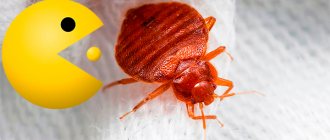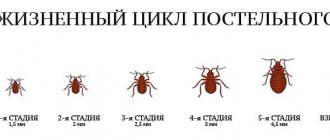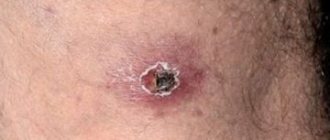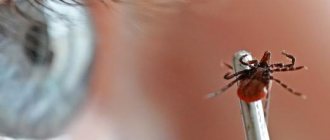Tick-borne infections (encephalitis, borreliosis or Lyme disease, ehrlichiosis, anaplasmosis, etc.) are diseases transmitted to humans by tick bites.
The most common tick-borne infection is ixodid tick-borne borreliosis (TBB) or Lyme disease, an infectious disease caused by the spirochete Borrelia burgdorferi, which is transmitted by ixodid ticks.
Every year, from 7 to 9 thousand cases of Lyme disease, which occurs in children and adults, are reported in the Russian Federation. The greatest risk of disease is associated with the spring-summer period, so there should be special vigilance at this time of year.
The incubation period for borreliosis ranges from 1 to 60 days (on average, 2 weeks).
What does the carrier of infection look like - the ixodid tick
Tick masks of borreliosis lie in the fact that often with borreliosis there is no information about tick suction. In addition, Lyme disease and other borrelioses, such as Borrelia miyamotoi, may generally develop in an erythematous form. And in this case it is very easy to miss the onset of the disease. As a result, the process moves into the second stage - organ damage, thereby contributing to the chronicization of the process with the subsequent development of severe pathology. Considering such organ damage, it is important to promptly consult an infectious disease doctor after the fact of tick bite.
Submit the tick for infection analysis
Ixodid ticks are often carriers of infections, which include tick-borne encephalitis (caused by tick-borne encephalitis virus), ixodid tick-borne borreliosis (Borrelia burgdorferi), human monocytic ehrlichiosis (Ehrlihia chaffeensis, Ehrlihia muris), human granulocytic anaplasmosis (Anaplasma phagocytophilum). The active season of ixodid ticks spans a long period - from late April to late autumn. This study makes it possible to diagnose the presence of pathogens in ticks and, if necessary, carry out prophylaxis and preventive treatment. Tick-borne encephalitis. The causative agent is Tick-borne encephalitis Virus, TBEV. A vector-borne viral disease caused by ixodid ticks. Characterized by seasonality (spring-autumn period). Approximately 70% of all cases of tick-borne encephalitis in Russia occur in the Urals, Siberia and the Far East. Most often, tick-borne encephalitis occurs in an erased form, however, clinically manifested forms of the disease can occur, incl. extremely severe - fever, viral meningitis and encephalitis. As a rule, after the encephalitic form with focal manifestations, persistent disturbances in the activity of the central nervous system develop.
Lyme borreliosis, Lyme disease or ixodic tick-borne borreliosis is a natural focal, multisystem infectious disease caused by spirochetes of the genus Borrelia. Clinically manifested by damage to the musculoskeletal system, nervous and cardiovascular systems, and skin. The group of ixodid tick-borne borrelioses consists of diseases most often caused by B.burgdorferi, B.garinii and B.afzelii. When Borrelia enters the body, tick-borne erythema migrans occurs. However, in almost half of the cases, erythema does not appear at the onset of the disease - the non-erythema form. The use of modern serological diagnostic methods makes it possible to timely detect borreliosis at the initial stage and significantly reduce the risk of developing severe chronic forms of Lyme disease. Antibodies of the IgM class are detected within 10-14 days from the moment of infection. Human granulocytic anaplasmosis is an acute infectious disease caused by the small intracellular bacterium Anaplasma phagocytophillum. Clinically manifested by symptoms of general intoxication, high fever, chills, and decreased blood pressure. The disease is accompanied by a decrease in cellular immunity due to damage to neutrophils and a decrease in the number of platelets, which is accompanied by an increased risk of bleeding. Human monocytic ehrlichiosis is an acute infectious focal zoonotic disease caused by bacteria of the genus Ehrlichia (E.chaffeensis, E.muris), which affect the central nervous system, bone marrow, liver, skin and other organs. Clinically manifested by a sharp increase in temperature, pain in muscles and joints, nausea, vomiting, and symptoms of general intoxication. Visual examination reveals a vesiculopapular rash. Children and people over 40 years of age are most often affected.
stages of borreliosis
The manifest form is characterized by clinical symptoms of borreliosis and the presence of persistence of the pathogen, latent infection is characterized only by the persistence of borrelia. The manifest form can be: acute - the duration of the disease is up to 3 months, subacute - from 3 to 6 months, chronic - persistence of symptoms for more than 6 months.
For the diagnosis of borreliosis infection, the fundamental factors are the timely detection of clinical symptoms and laboratory confirmation of this disease.
Stage I.
Borreliosis, erythema migrans
Borreliosis, migrating “ring-shaped” erythema (local infection). The duration of the local stage is from 1 to 14 days.
Borreliosis, ring-shaped erythema.
Stage II. At this stage of borreliosis ( dissemination of infection), the following organ lesions are noted (from 2 weeks to 3 months from the moment of tick suction):
- regional lymphadenitis;
- dermatoborreliosis (MME, lymphocytoma);
- neuroborreliosis (meningitis, Bannwart syndrome, facial neuritis, encephalitis, celebrovascular disorders, polyneuropathy, myelitis, cephalalgia, chorea);
- ophthalmic borreliosis (conjunctivitis, uveitis, scleritis, iridocyclitis, optic nerve nervitis);
- Lyme carditis (cardiac dystrophy, myocarditis, pancarditis, AV blockade I-III degree, arrhythmias); Lyme arthritis (arthralgia, multiple arthritis, tenosynovitis);
- Lyme hepatitis;
- Lyme myositis;
- Lyme orchitis.
Stage III. The late stage of borreliosis corresponds to a chronic persistent infection (from 3 months to 5 years from the moment of tick bite).
This stage of the disease is characterized by the development of progressive chronic inflammation in the skin, joints or nervous system, less often in other organs, leading to atrophic and degenerative changes in these organs. With chronic infection, variants of a continuous course can be observed, when the signs of the disease progress over time without remissions, or a recurrent course with periods of remission of varying durations. This:
- neuroborreliosis (encephalopathy, disseminated leukoencephalomyelitis, polyradiculoneuropathy, multiple mononeuritis, transient cerebrovascular accident, cerebral vasculitis);
- dermatoborreliosis (atrophic acrodermatitis, which is differentiated from scleroderma, eosinophilic fasciitis, Parry-Romberg syndrome);
- ophthalmic borreliosis (chorioretinitis, keratitis);
- Lyme carditis (congestive cardiomyopathy, myocardial dystrophy, myocardiosclerosismyocarditis);
- Lyme arthritis.
This stage of the disease is characterized by the development of progressive chronic inflammation in the skin, joints or nervous system, less often in other organs, leading to atrophic and degenerative changes in these organs. With a chronic infection, there may be continuous variants, when the signs of the disease progress over time without remissions, or a recurrent course with periods of remission of varying lengths.
In cases where organ lesions are not detected by objective methods, borreliosis is unlikely.
Patients with serous meningitis, neuropathies and other organ lesions are subject to mandatory examination to exclude tick-borne infections!
Detailed description of the study
Tick-borne borreliosis
Systemic tick-borne borreliosis (Lyme disease, Lyme borreliosis) is a natural focal, vector-borne disease transmitted by ticks with primary damage to the skin, nervous system, cardiovascular system and musculoskeletal system, prone to chronicity. The causative agent is a gram-negative, anaerobic, motile spiral bacterium of the genus Borrelia of the order Spirochaetales. The reservoir and source of infection are many species of wild and domestic vertebrate animals and birds (mainly various types of wild rodents, white-tailed deer, elk, etc.). In natural foci, pathogens circulate between ticks and wild animals. An infected person is not a source of infection for humans. The transmission mechanism is most often transmissible, the transmission route is through tick bites and its saliva. Another possible route of transmission of pathogens from animals to humans may be the nutritional route, which occurs when consuming raw milk (mainly goat milk) or dairy products without heat treatment. A proven fact is the possibility of transplacental infection of the fetus with borreliosis in pregnant women. Post-infectious immunity is non-sterile, species-specific, and re-infection is possible several years after recovery. The incidence of the disease in rural and urban populations is approximately the same; infection occurs most often during visits to forests, forest parks, and garden plots. Spring-summer seasonality is determined by the period of tick activity (from April to October). . The incubation period varies from 1 to 50 days, averaging 10-12 days. Being intracellular parasites, when disseminating, Borrelia penetrate into the cells of the reticulohistiocytic system (including macrophages), endothelial cells of various organs and systems, which is clinically manifested by the development of multiorgan pathology (erythema migrans, lymphocytic meningoradiculoneuritis, migratory arthralgia, atrophic acrodermatitis, focal scleroderma, chronic encephalomyelitis, paraparesis, multiple mononeuritis, etc.). The prognosis is favorable, despite the long course of the disease. Very important to confirm the diagnosis is a serological test, which is based on the detection of antibodies to Borrelia in the blood serum using an enzyme-linked immunosorbent assay (ELISA). It is important to examine paired sera with an interval of 20-30 days. Detection of IgM indicates an acute infectious process. Late stages of the disease are characterized by a significant increase in IgG antibodies, especially in acrodermatitis atrophica (100% of cases). Long-term persistence of high IgG values indicates an ongoing infectious process and the development of chronic forms of the disease.
diagnostics
IT IS NECESSARY TO REMEMBER THAT WHEN AN ATTACKED TICK IS DETECTED, IT MUST BE REMOVED, PRESERVING THE INTEGRITY OF ITS BODY AND URGENTLY SUBMITTED FOR ANALYSIS FOR ITS INFECTION WITH THE ABOVE STATUS PATIENTS.
Due to methodological difficulties, the use of bacterial methods for identifying the pathogen is limited, and for etiological diagnosis it is practically excluded.
The use of PCR analysis, which includes the isolation of Borrelia DNA in the blood of patients, as an etiological diagnosis is ineffective and uninformative, due to the possible penetration of the pathogen into organs and tissues, bypassing the bloodstream. The sensitivity of PCR studies in the early stages of the disease is no more than 30%, and when the process becomes chronic it reaches only 10%.
Basic laboratory diagnostics for borreliosis, anaplasmosis, ehrlichiosis:
- Enzyme-linked immunosorbent assay (ELISA), which allows the detection of specific IgM/,IgG antibodies to the pathogen in the patient’s blood. Specific antibodies to Borrelia burgdorferi begin to be detected 1.5-2-4 weeks after the development of the infectious process. First, class M immunoglobulins are detected, and then, 1.5 - 3 months after infection, class G immunoglobulins. This method is the most informative, simple, and diagnostically significant method.
- As a reference test, a modern serological method is used - immunoblotting in the lineblot or westernblot modifications, which can be used to detect antibodies to highly specific pathogen proteins, separated by molecular weight using electrophoresis. This highly sensitive and highly specific method helps to accurately confirm the presence of the disease.
treatment of tick-borne infections in adults and children in our center
If you suspect a tick-borne infection, you need to carry out a full range of clinical and laboratory tests to exclude possible tick-borne encephalitis, borreliosis, anaplasmosis, ehrlichiosis, or a mixed infection.
If a tick-borne infection is confirmed, comprehensive treatment is necessary. If a tick-borne infection is not treated, it is fraught with the development of complications, including disability and death.
If you suspect an infection, you can contact an infectious disease immunologist at our medical center to optimize the diagnosis and treatment of your disease. An infectious disease immunologist at our center with extensive clinical experience guarantees successful prevention of infection in the early (incubation period) before the development of the disease and treatment of tick-borne infection if you contact our medical center in a timely manner. We also have modern diagnostic equipment and laboratory capabilities.
To make an appointment with a doctor, you can call +.
What tests are taken?
Borreliosis requires a comprehensive diagnosis, and patients may be prescribed the following tests:
- IgM antibodies: antibodies characteristic of the active stage of the disease - present at the very beginning and gradually disappear. An IgM antibody test allows you to determine the stage and evaluate the effectiveness of treatment for borreliosis.
- IgG antibodies: produced during illness and remain in the body, providing immunity to borreliosis. By the end of the disease, the number of IgG antibodies exceeds IgM.
- PCR diagnostics: 100% accurate method for identifying tick-borne pathogens based on RNA and DNA testing.










